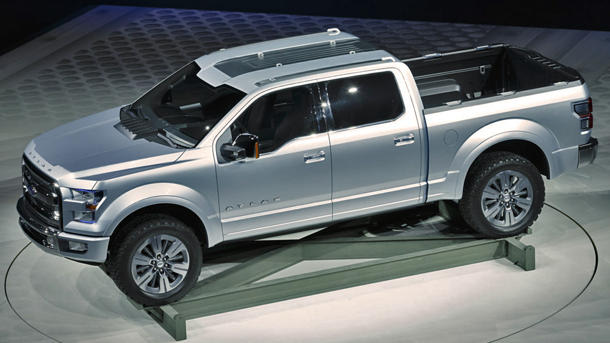This was supposed to be the Detroit auto show where General Motors put a
spotlight on the forthcoming refresh of the Chevy Silverado/GMC Sierra pickups,
and Ram touted its win as North American Truck of the Year. Instead, their
thunder has been hauled away by the show's surprise, the Ford Atlas concept —
highlighting where Ford will likely take the next F-Series pickups, and what it
will take to meet future fuel economy standards.With a
new F-Series pickup, Ford's most profitable and best-selling vehicle, not due
for a redesign until the 2015 model year, the Atlas was short of key details,
like specific engine designs or output. But the trend lines show where Ford has
to go: producing more power while burning less fuel, and to that end the Atlas
prepares F-Series buyers for a world where every piece of the truck plays some
role in higher mileage.
Take the wheels. If they seem a bit busy, it's because they contain shutters
that close at higher speeds, improving aerodynamics. There's also air dams that
deploy in front of the wheels and behind the massive chrome grille for the same
reason. Ford chief engineer Raj Nair said the new truck will need to lose up to
700 lbs. in order to meet the U.S. fuel economy standards rising between now and
2025, including some "funky" things like aluminum frames.
"It's always getting harder. The rate of fuel economy improvement that needed
is ever increasing, both from customer demand and regulatory requirement," Nair
says.
Ford has successfully shown truck buyers will choose something other than a
V-8 engine if given a practical alternative; some 43 percent of F-150 buyers
pick a twin-turbo EcoBoost V-6, and some version of that engine powers the
Atlas. The concept had a start-stop engine system; Nair said Ford was still
exploring a potential deal with Toyota to jointly design and build a hybrid
system for pickups and larger vehicles.
As for the Atlas' style, the ideas seem less far out than close to
production. The massive chrome grille will look familiar to anyone who's seen a
Super Duty. High-end versions of the F-Series trucks are already luxury
vehicles, so lux-world touches like LED headlamps and on-board WiFi don't seem
surprising. Other technology aimed at helping drivers -- a 360-degree roof
camera, a cargo cradle built into the tailgate for additional storage -- also
seem well within reach.
While Chevy played conservative with the new Silverado, the Atlas suggests
Ford will be willing to take more risks when its turn comes — and stealing the
spotlight back will be more difficult.







